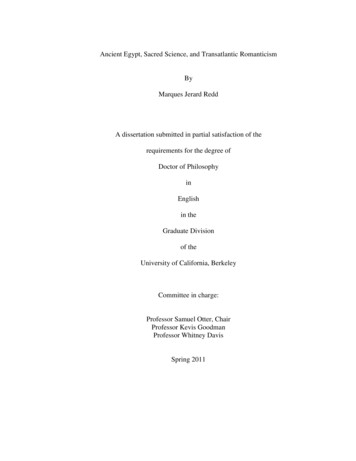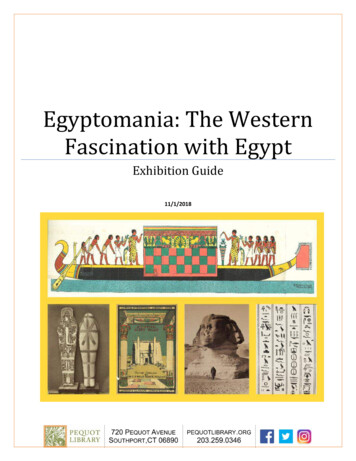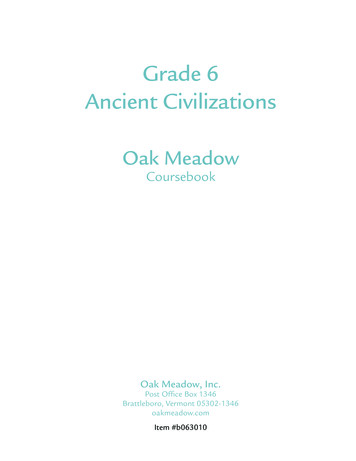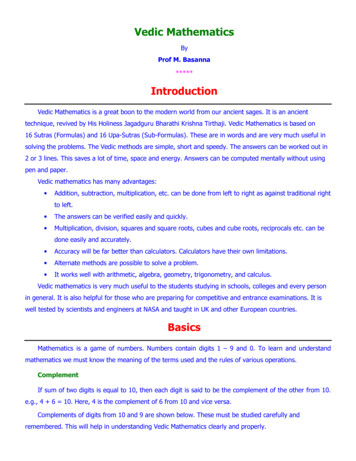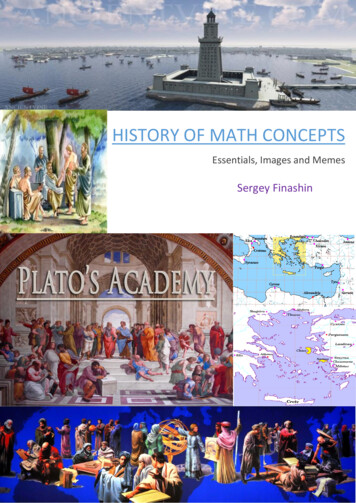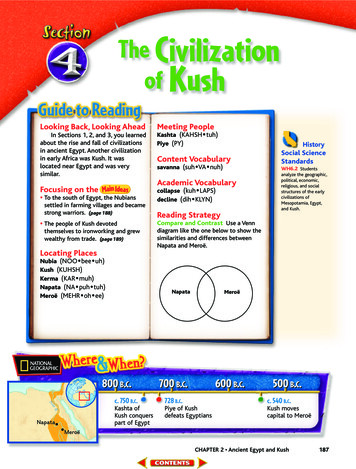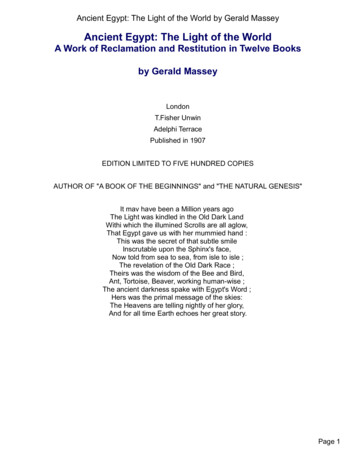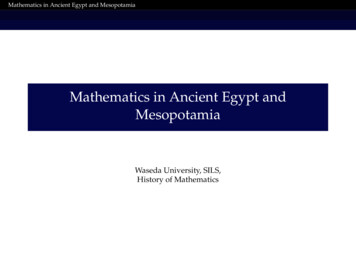
Transcription
Mathematics in Ancient Egypt and MesopotamiaMathematics in Ancient Egypt andMesopotamiaWaseda University, SILS,History of Mathematics
Mathematics in Ancient Egypt and MesopotamiaOutlineIntroductionEgyptian mathematicsEgyptian numbersEgyptian computationSome example problemsBabylonian MathematicsBabylonian numbersBabylonian computationSome example problems
Mathematics in Ancient Egypt and MesopotamiaIntroductionHow do historians divide up history?The large scale periodization used for (Western) history is thefollowing: Ancient: the distant past to, say, 5th or 6th century CE Medieval: 6th to, say, 15th or 16th century Modern: 16th century to the present
Mathematics in Ancient Egypt and MesopotamiaIntroductionAncient cultures around the Mediterranean
Mathematics in Ancient Egypt and MesopotamiaIntroductionHow do we study ancient history? What are our ancient sources? material objectsimagestextsa. found as ancient material objectsb. transmitted by tradition What is the condition of the sources?Wherever possible, we focus on reading andunderstanding texts. When we study objects, without any textual support orevidence, it is very easy to me mislead, or to have veryopen-ended and unverifiable interpretations.
Mathematics in Ancient Egypt and MesopotamiaIntroductionHow can we interpret these objects without texts?11The pyramids of Giza.
Mathematics in Ancient Egypt and MesopotamiaIntroductionOr how about these?22Stonehenge in Wiltshire, England.
Mathematics in Ancient Egypt and MesopotamiaIntroductionBut . . . how do we interpret these texts?
Mathematics in Ancient Egypt and MesopotamiaIntroductionThings we might want to know about a text What does it say, what are its contents? Who wrote it? What was its purpose? What can we learn from the text itself about its author? How much do we need to know about the author tounderstand the text?Can we situate it in a broader context? The “horizontal” context of the society in which it wascomposed?The “vertical” context of earlier and later developments?
Mathematics in Ancient Egypt and MesopotamiaIntroductionEvidence for Egyptian and Babylonian mathematics Egypt: A handful of Old Egyptian Hieratic papyri,wooden tables and leather rolls, a few handfuls of MiddleEgyptian Demotic papyri, less than a hundred Greekpapyri, written in Egypt and forming a continuoustradition with the older material. Mesopotamia: Thousands of clay tablets containingSumerian and Assyrian, written in cuneiform. All of this material is scattered around in a number ofdifferent library collections, poses many difficulties toscholars and involves many problems of interpretation. These texts are written in dead languages.
Mathematics in Ancient Egypt and MesopotamiaEgyptian mathematicsThe place of mathematics in Egyptian cultureMediterranean owerEgyptMoerisMeydumLahunSerabit al-KhadimriverNilef ofezSuBahariya OasisBeni HasanHermopolisAmarnaAsyutEastern DesertBadariQauWestern DesertA very small group of professionalscribes could read and write.Red SeaAkhmimThinisAbydosNileKharga Oasis TimnaHerakleopolisGulEgyptian, a Semitic language, waswritten in two forms, Hieroglyphicand Hieratic.CairoSaqqaraDahshurLakeGreat BitterLakeHeliopolisGiza10060ba(km)Faiyum AvarisNile DeltaESWPelusiumTanisBusirisWadi matThebesDakhla OasisUpperEgypt(Luxor and Karnak)TodHierakonpolisEdfuKom OmboAswanBernikeFirst CataractDunqul Oasis Nabta PlayaWadi AllaAbu SimbelqiBuhenSecond CataractKushdiWaaabbgGaThe only evidence we have formathematics in ancient Egypt comesfrom the scribal tradition.Nubian DesertThird CataractKerma The study of mathematics was a keycomponent of a scribe’s amiettaRosettaAlexandriaof AqaAncient Egypt was an autocraticsociety ruled by a line of Pharaohs,who were thought to be divine.Gulf NileriverKawaFourth CataractNapataGebel BarkalFifth CataractMeroe
Mathematics in Ancient Egypt and MesopotamiaEgyptian mathematicsOur evidence for Egyptian mathematics Ancient Egyptian mathematics is preserved in Hieraticand Demotic on a small number of papyri, wooden tabletsand a leather roll. Middle and late Egyptian mathematics is preserved on afew Demotic and Coptic papyri and many more Greekpapyri, pot sherds and tablets. This must be only a small fraction of what was onceproduced, so it is possible that our knowledge of Egyptianmathematics is skewed by the lack of evidence.
Mathematics in Ancient Egypt and MesopotamiaEgyptian mathematicsAn example: The Rhind Papyrus, complete
Mathematics in Ancient Egypt and MesopotamiaEgyptian mathematicsAn example: The Rhind Papyrus, end
Mathematics in Ancient Egypt and MesopotamiaEgyptian mathematicsAn example: The Rhind Papyrus, detail
Mathematics in Ancient Egypt and MesopotamiaEgyptian mathematicsEgyptian numbersEgyptian numeral system A decimal (base-10) system Not a place-value system. Every mark had an absolutevalue. Unordered
Mathematics in Ancient Egypt and MesopotamiaEgyptian mathematicsEgyptian numbersEgyptian numeral system
Mathematics in Ancient Egypt and MesopotamiaEgyptian mathematicsEgyptian numbersSome examples: an inscribed inventory
Mathematics in Ancient Egypt and MesopotamiaEgyptian mathematicsEgyptian numbersSome examples: accounting33This text uses both Hieroglyphic and Hieratic forms.
Mathematics in Ancient Egypt and MesopotamiaEgyptian mathematicsEgyptian numbersEgyptian fraction system The Egyptians only used unit fractions (we would write n1 ). They wrote a number with a mark above it, and hadspecial symbols for 12 , 13 , 41 and 23 . This makes working with fractions tricky. Doubling an “even-numbered” fraction is simple (ex.11110 10 5 ), however doubling an “odd-numbered”1fraction is not straightforward (ex. 15 15 13 15) . And, collections of unit fractions are often not unique (ex.11111115 5 3 15 4 10 20 ).We generally write Egyptian fractions as 3̄ 2 , 2̄ 1 , 3̄ 13 , 4̄ 14 , etc. Why not just use n1 ?32
Mathematics in Ancient Egypt and MesopotamiaEgyptian mathematicsEgyptian numbersEgyptian fraction system
Mathematics in Ancient Egypt and MesopotamiaEgyptian mathematicsEgyptian computationMultiplication The Egyptians carried out multiplication by a series ofsuccessive doubling and then additions. For example, tomultiply 12 by 12, we find, in Rhind P. #32:.2\4\812244896sum 144 The scribe has written out a list of the successive doublesof 12 then put a check by the ordering numbers (1, 2, 4, 8,.) that total to 12. The doubles that correspond to these ordering numbersare then summed (48 96 144).
Mathematics in Ancient Egypt and MesopotamiaEgyptian mathematicsEgyptian computationDivision Division is an analogous process, using halving and unitfractions. For example, to divide 19 by 8 we find, in RhindP. #24:. 8\ 2 162̄ 4\ 4̄ 2\ 8̄ 1sum 19 In this case, the numbers on the right side sum to 19(16 2 1 19), so the ordering numbers must be addedtogether to give the answer (2 4̄ 8̄). The answer is notstated explicitly.
Mathematics in Ancient Egypt and MesopotamiaEgyptian mathematicsSome example problemsThe method of false position, 1 A class of problems, known as ,h., problems (,h., means“heap” or “quantity”), reveals a method for solvingproblems of the form x ax b. For example, in Rhind P.#26, we have: “A quantity, its 4̄ [is added] to it so that 15 results. What isthe quantity? [That is, x x4 15]Calculate with 4. [The assumed, “false” value.]You shall callculate its 4̄ as 1. Total 5.Divide 15 by 5.\. 5\ 2 103 shall result
Mathematics in Ancient Egypt and MesopotamiaEgyptian mathematicsSome example problemsThe method of false position, 2 Multiply 3 times 4. 32 6\ 4 1212 shall result\ . 12\ 4̄ 3Total 15” We start with an assumed value, 4, and find out what partof the final result, 15, it produces. Then we correct by thispart. Why would the text treat such trivial calculations in thiskind of detail?
Mathematics in Ancient Egypt and MesopotamiaEgyptian mathematicsSome example problems“I met a man with seven wives. . . ”4 P. Rhind #79: “There were 7 houses, in each house 7 cats,each cat caught 7 mice, each mice ate 7 bags of emmer, andeach bag contained 7 heqat. How many were therealtogether?” Answer (modern notation): 7 72 73 74 75 19607. Is this a real problem? What is the point of it?4An old English nursery rhyme: “As I was going to St. Ives: I met a man withseven wives: Each wife had seven sacks: Each sack had seven cats: Each cat hadseven kits: Kits, cats, sacks, wives: How many were going to St. Ives?”
Mathematics in Ancient Egypt and MesopotamiaBabylonian MathematicsThe place of mathematics in Mesopotamian culture Ancient Mesopotamianculture had two primaryinstitutions, the King and theTemple, but wealthymerchants also played animportant role in society. Mathematics was practiced bya small group of literatescribes. They made their livingworking as scribes andaccountants, mathematics wasa side product of their primaryrole.
Mathematics in Ancient Egypt and MesopotamiaBabylonian MathematicsThe place of mathematics in Mesopotamian culture Mathematics was developedfor both practical purposesand to create a professionaldistinctions between thosewho could and those whocould not solve advancedproblems. After the conquests ofAlexander, Mesopotamianmathematicians, workingmostly in the temple, appliedtheir skills to the productionof a highly precisemathematical astronomy.
Mathematics in Ancient Egypt and MesopotamiaBabylonian MathematicsOur evidence for Babylonian mathematics Ancient Mesopotamian mathematics was written with astylus on clay tablets. We have hundreds of thousands of tables, the majority ofwhich have numbers on them and many of which havestill not been read or understood. The tablets are written in the Cuneiform script, mostly inthe Sumerian and Assyrian languages. (Assyrian is aSemitic language, while Sumerian is unrelated to any otherlanguage we know.)
Mathematics in Ancient Egypt and MesopotamiaBabylonian MathematicsAn Example: A Sumerian tablet
Mathematics in Ancient Egypt and MesopotamiaBabylonian MathematicsBabylonian numbersThe Babylonian numeral system A base-60 number system It was a place-value system, but a place holder (like our 0)was only used inconsistently. Also, there was no cleardivision between the integer and fractional parts. Ordered (Left to right, top to bottom)
Mathematics in Ancient Egypt and MesopotamiaBabylonian MathematicsBabylonian numbersBabylonian numeral system
Mathematics in Ancient Egypt and MesopotamiaBabylonian MathematicsBabylonian numbersSome examples: Pairs of “Pythagorean” triples55Plimpton 322 (Columbia University). “Pythagorean” triples are sets of threeintegers, {a, b, c}, such that a2 b2 c2 .
Mathematics in Ancient Egypt and MesopotamiaBabylonian MathematicsBabylonian numbersSome examples: Babylonian lunar theory66Neugebauer, Astronomical Cuneiform Texts (ACT), 122.
Mathematics in Ancient Egypt and MesopotamiaBabylonian MathematicsBabylonian numbersThe Babylonian fraction system A base-60 fractional system. Modern scholars use a system of comas (,) and colons (;) toseparate the places from each other and to indicate whichnumber are integers and which are fractional parts.7 So anumber of the formxn , ., x2 , x1 , x; xf 1 , xf 2 , .xfm xxxxn 60n . x2 602 x1 60 x 60f 1 60f 22 . 60fmm For example,51101; 24, 51, 10 1 2460 602 603 1.414212963.Or, 8, 31; 51 8 60 31 1720 512.85.7Due to Otto Neugebauer.
Mathematics in Ancient Egypt and MesopotamiaBabylonian MathematicsBabylonian computationComputation in base-60 Because it was a place-value system, the Babyloniansystem allowed much simpler calculations, in many wayssimilar to contemporary styles. The only difficulty was in the multiplication table, which ifcomplete would have had 60 by 60 terms. Since memorizing 3600 terms was unmanageable, insteadthey worked with certain “principal” tables. They also composed tables of pairs of reciprocals (n, and1/n), where in the place of 1 could be 1, 60, 3600, etc.
Mathematics in Ancient Egypt and MesopotamiaBabylonian MathematicsSome example problemsAn interesting tablet (YBC, 7282)88Yale Babylonian Collection (YBC), 7282.
Mathematics in Ancient Egypt and MesopotamiaBabylonian MathematicsSome example problemsAn interesting tablet (YBC, 7282)
Mathematics in Ancient Egypt and MesopotamiaBabylonian MathematicsSome example problemsAn interesting tablet We have three numbersa 30,b 1, 24, 51, 10,c 42, 25, 35. If we write as 30;0 and 1;24,51,10 and 42;25,35, then c ab. b 2. Indeed, (1; 24, 51, 10)2 1; 59, 59, 59, 38, 1, 40.This, and many other tablets, indicate that the Babylonianmathematician knew something like the Pythagoreantheorem (a2 b2 c2 ).
Mathematics in Ancient Egypt and MesopotamiaBabylonian MathematicsSome example problemsHow did they know this? We do not know, but perhaps they used a “cut-and-paste”argument. Since the two squares are “obviously” the samesize, the red plus yellow squares must equal the whitesquares. Is this a proof?
Mathematics in Ancient Egypt and MesopotamiaBabylonian MathematicsSome example problemsGeometrical algebra, 1 One of the significant mathematical accomplishments ofthe Mesopotamian scribes was a general method forsolving certain classes of algebraic equations (althoughthey did not think of them in this abstract way). It has only been fairly recently,9 that scholars have reachedthe consensus that they used a kind of geometrical algebra. That is, they imagined the problem as represented by arectangular figure and then “cut-and-pasted” parts of thisfigure in order to solve the problem.9Since the 1990s.
Mathematics in Ancient Egypt and MesopotamiaBabylonian MathematicsSome example problemsGeometrical algebra, 2 The technique was probably originally developed for thevery common types of problems where: We know the area a plot of land and the sum or difference ofthe sides and we want to know the length and width,individually. (Is this a real, or practical, problem?)That is, we have xy a and x y b, to find x and y.
Mathematics in Ancient Egypt and MesopotamiaBabylonian MathematicsSome example problemsGeometrical algebra, 2Probably, they worked as follows:Suppose we start with complete upperrectangle, we mark off a square section(brown) at one end of the plot, then wedivide what is left over into two equalstrips (blue).Then we move one of the strips andcomplete the square (green).Then from the area of the big square wesolve for the side of the green square,from which we can determine the sidesof the original rectangle.
Mathematics in Ancient Egypt and MesopotamiaBabylonian MathematicsSome example problemsA geometrical algebra problem These types of techniques could be used to solve a widevariety of algebraic problems.YBC, 6967: “A reciprocal exceeds its reciprocal by 7. Whatare the reciprocal and its reciprocal? You: break in two the7 by which the reciprocal exceeds its reciprocal so that 3;30will come up. Combine 3;30 and 3:30 so that 12;15 willcome up. Add 1,00, the area, to the 12;15 which came upfor you so that 1,12;15 will come up. What squares to1,12;15? 8:30. Draw 8;30 and 8:30, its counterpart, and thentake away 3:30, the holding-square, from 1, and add to 1.One is 12, the other is 5. The reciprocal is 12, its reciprocalis 5.”That is, we start with a relation of the form n 60/n 7 andwe want to determine the value of n and 60/n.
Mathematics in Ancient Egypt and MesopotamiaBabylonian MathematicsSome example problemsAdvanced mathematics in Mesopotamia Mesopotamian scribes developed methods for solvingmany problems that had no immediate practicalapplication. Mathematical problem solving appears to have become amark of distinction in the scribal profession. One major area of application, however, was thedevelopment of mathematical astronomy, which was usedto predict significant events of the heavenly bodies andwas of great value as an aid to divination. In these ways, the production and teaching of mathematicshad a well defined place in Mesopotamia culture.
How do historians divide up history? The large scale periodization used for (Western) history is the following: Ancient: the distant past to, say, 5th or 6th century CE Medieval: 6th to, say,
